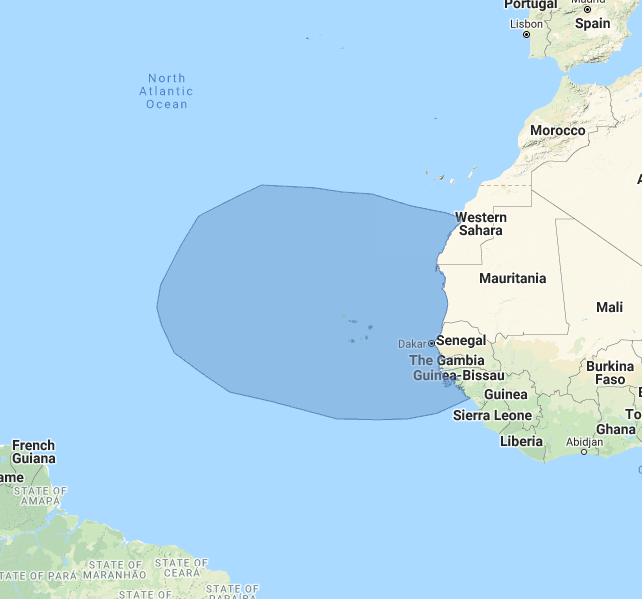Birdfinding.info ⇒ Locally common in the Cape Verde archipelago and nearby offshore waters. At-sea sight records and limited satellite-tracking data indicate that it tends to disperse more to the west and south of Cape Verde than to the north and east.
Cape Verde Storm-Petrel
Hydrobates jabejabe
Breeds in Cape Verde; disperses into the tropical North Atlantic.
Breeds on islands and islets nearly throughout the Cape Verde archipelago on steep rocky slopes in coastal zones and interior mountains. It is known or suspected of nesting on Santo Antão, Santa Luzia, Ilhéu Branco, Ilhéu Raso, São Nicolau, Sal (on the islet Rabo-de-Junco), Boa Vista (on the islets Curral Velho and Pássaros), Maio (on the islet Laje Branca), Santiago, Fogo, and the Ilhéus do Rombo.
Breeding activity apparently occurs year-round or nearly so, as eggs have been found in nests from at least October to late May. There may be two seasonal peaks: one in late fall and the other in spring.
Nonbreeding birds disperse over the eastern tropical zone of the North Atlantic. Satellite tracking data and shipboard observations suggest that they usually remain far offshore between 20° North and the Equator, and tend to head west or south from Cape Verde toward the central Atlantic between West Africa and northern South America.
Identification
As a cryptic species within the Band-rumped Storm-Petrel complex, Cape Verde is visually indistinguishable from other band-rumped-type storm-petrels under most circumstances.
Its only observable distinguishing trait to confirm identification is the set of vocalizations it gives on the breeding grounds at night (see below). Visual identification is based solely on geographical probability—any generically band-rumped-type storm-petrel observed in the eastern North Atlantic between 20° North and the Equator is generally presumed to be Cape Verde. (This is despite the fact that the other North Atlantic forms—Monteiro’s, “Grant’s”, and “Madeiran”—presumably overlap with Cape Verde to some unknown extent, and both South Atlantic forms—“Gulf of Guinea” and “St. Helena”—might as well.)

Cape Verde Storm-Petrel—identification presumed based on location. (Offshore south of Cape Verde; May 4, 2011.) © Graham Ekins
Like other band-rumped-type storm-petrels, Cape Verde is dark-brown overall, with an even white band across the rump that usually extends partway down the sides of the rump to the undertail. Its tail usually appears either square-tipped or shallowly notched.
Band-rumped-type storm-petrels strongly resemble storm-petrels of other groups (such as Leach’s and Wilson’s), and are best distinguished by their characteristic flight pattern: which is comparatively steady and stable, often gliding on flat wings like a shearwater.

Cape Verde Storm-Petrel, showing white band on rump. (Branco, Cape Verde; March 24, 2007.) © Richard Bonser
As with most dark storm-petrels, all band-rumped-types typically show a paler brown or whitish diagonal stripe on the wing coverts, but the boldness varies depending on molt-stage and lighting. So the apparent color and boldness of the wingbar can provide clues to the age and molt-stage of closely observed individuals.
Juveniles and freshly molted adults have the most pronounced wingbars. On juveniles the bar appears silvery. On fresh adults, the bar is blond. With feather-wear, the bar diminishes and may disappear entirely by the time the next molt begins.

Cape Verde Storm-Petrel, juvenile showing silvery fringes on wing coverts. (Ilhéu Rabo-de-Junco, Cape Verde; August 16, 2019.) © Marcos Hernández
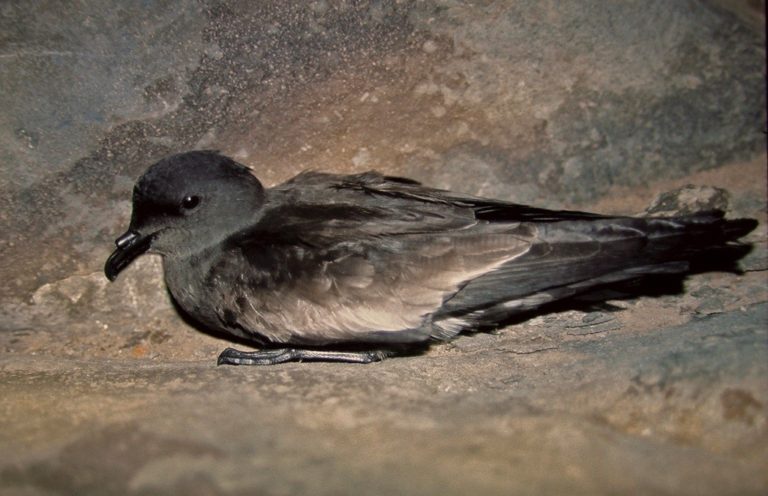
Cape Verde Storm-Petrel, adult showing blond fringes on wing coverts. (Ilhéu Raso, Cape Verde; December 2002.) © Mark Bolton
Voice. Two types of calls are heard at breeding colonies: chattering and purring. Both resemble the equivalent calls of other storm-petrels, but differ in their patterns.
Cape Verde’s chatter call is longer and more complex than the calls of other North Atlantic band-rumped-types: typically comprising eleven to sixteen notes, whereas the others vary from four up to eleven (4 to 6 in Monteiro’s; 9 in “Grant’s”; 6 to 11 in “Madeiran”; 11 to 16 in Cape Verde).
Cape Verde’s purring call consists of a very long, rough purr or rattle followed by a short chatter call. The total length of these calls averages over twenty seconds—compared to averages of two to four seconds in the other North Atlantic band-rumped-types.
(For a detailed review with more recordings and sonograms, see The Sound Approach: Cape Verde Storm-Petrel.)
Notes
Monotypic species. Formerly classified as a subspecies of Band-rumped Storm-Petrel (H. castro), but recognized as a separate species due to vocal differences and genetic analyses indicating that it diverged between approximately 200,000 and 340,000 years ago.
See below for a comparison of Cape Verde Storm-Petrel with other Atlantic members of the Band-rumped Storm-Petrel complex.
Cf. Other Atlantic Band-rumped-type storm-petrels. At least six cryptic species or forms in the Band-rumped Storm-Petrel complex have been recognized in the Atlantic. Four breed on North Atlantic archipelagos of Macaronesia and two on widely scattered islands of the South Atlantic. Apart from their breeding grounds, the ranges of these forms remain mostly unknown. Sightings are scarce and the forms are extremely difficult to distinguish from one another at sea.
The four North Atlantic forms overlap with one another to varying degrees and are known to differ vocally. In brief, all four have two similar call types—chattering and purring—which vary in length, pattern, and complexity. Differing calls have helped to confirm their respective breeding distributions, but they generally call only on the breeding grounds and only at night.
In most cases, under most conditions, the visual differences among the forms are too subtle and inconsistent for field identification. With that caveat, following is a summary of factors that might help in exceptional circumstances—the forms are listed by the average latitudes of their breeding grounds, from north to south.

Cape Verde Storm-Petrel—identification presumed based on the location, far out at sea south of Cape Verde, though any of the Atlantic band-rumped forms could occur there at any time of year. (May 4, 2011.) © Graham Ekins
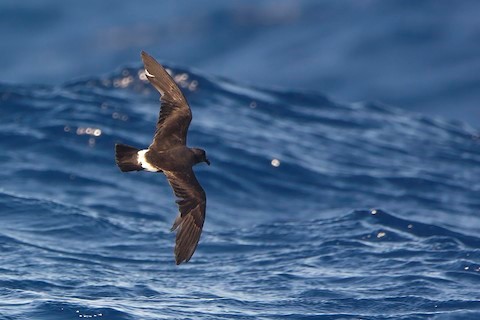
“Madeiran Storm-Petrel”, H. c. castro —likely this subspecies, based on molt-stage, season, and location within its known breeding range—but these factors are also consistent with Monteiro’s, Cape Verde, and first-year “Grant’s”, all plausible alternative identifications. (Offshore northeast of Lanzarote, Canary Islands, Spain; November 1, 2014.) © Miguel Rouco
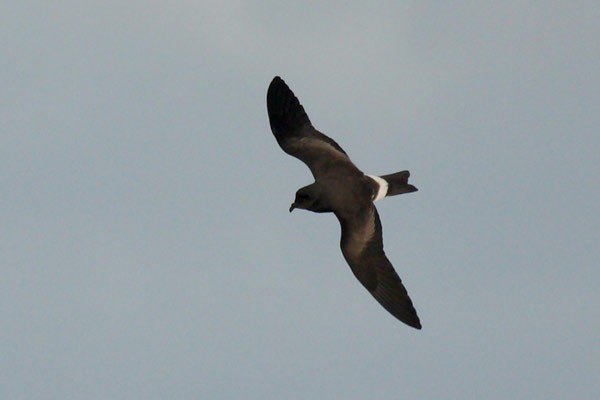
Monteiro’s Storm-Petrel—based on large samples of measured individuals at their Azorean breeding sites, Monteiro’s tends to have a more deeply notched tail than “Grant’s”, but their measurements overlap. (Offshore from Graciosa, Açores, Portugal; May 2011.) © Gareth Knass

“Gulf of Guinea Storm-Petrel”, H. c. ssp. nova, showing apparently thin rump-band and long-looking tail. © William H. Wagstaff
Monteiro’s Storm-Petrel (monteroi): Breeds in the Azores from March to October (eggs laid from early May to early July). Gives the shortest, simplest calls, with a rougher, scratchier quality than the others. Relatively small-bodied, long-tailed, and long-winged, and usually has a visibly notched tail.
“Grant’s Storm-Petrel” (ssp. nova): Breeds from the Azores east to the Berlengas and south to the Canaries from August to April (eggs laid from early October to early December). Calls end with signature punctuation. Relatively large and robust, and has a squarish or shallowly notched tail. Post-breeding adults show heavy feather-wear and/or molting flight feathers most noticeably from April to June—when Monteiro’s and “Madeiran” are fresh-plumaged.
“Madeiran Storm-Petrel” (castro): Breeds in Madeira, the Selvagens, and the Canaries from April to October (eggs laid in June and July). Calls are squeaky, rapid, about intermediate in length between Monteiro’s and Cape Verde, and lack the particular ending of “Grant’s”. Relatively small and slim overall; tail can appear either square-tipped or notched.
Cape Verde Storm-Petrel (jabejabe): Breeds in Cape Verde over an extended season, possibly year-round with two peaks—one from October into winter, the other from April into summer. Gives the longest, most complex calls, and genetic analyses indicate that it is the oldest divergent lineage in the band-rumped complex. Proportions are average, and has a squarish or shallowly notched tail.
“Gulf of Guinea Storm-Petrel” (ssp. nova): Breeds on São Tomé over an extended season, possibly year-round. Calls are relatively long and complex, suggesting an affinity with Cape Verde. Appears slightly larger than other forms, with a narrow white rump band and long-looking squarish or shallowly notched tail
“St. Helena Storm-Petrel” (helena): Breeds on St. Helena and Ascension in two seasons—possibly multiple distinct forms or cryptic species—one from October to March, the other from April to September. Attends the nest diurnally. On some individuals the white rump band extends far down undertail coverts. Slightly larger than most other forms; usually shows a visibly notched tail.
Additional Photos of Cape Verde Storm-Petrel

Cape Verde Storm-Petrel—identification presumed based on location. (Offshore south of Cape Verde; May 4, 2011.) © Graham Ekins
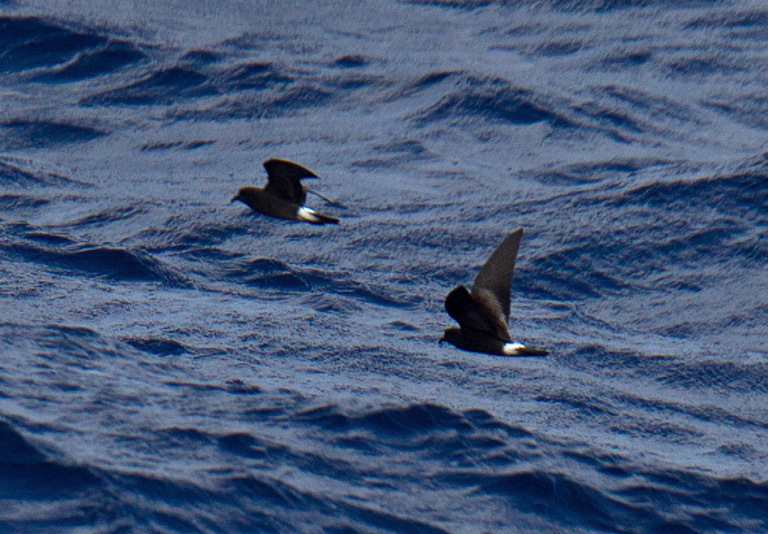
Cape Verde Storm-Petrel—identification presumed based on location. (Offshore south of Cape Verde; May 4, 2011.) © Graham Ekins

Cape Verde Storm-Petrel, showing notch in tail. (Cape Verde.) © Biosfera Cabo Verde

Cape Verde Storm-Petrel, juvenile. (Ilhéu Rabo-de-Junco, Cape Verde; August 16, 2019.) © Marcos Hernández
References
Aves Marinhas de Cabo Verde. 2021. Pedreirinho. https://avesmarinhasdecaboverde.info/aves-marinhas/pedreirinho/
BirdLife International. 2018. Hydrobates jabejabe. The IUCN Red List of Threatened Species 2018: e.T132434704A132434879. https://dx.doi.org/10.2305/IUCN.UK.2018-2.RLTS.T132434704A132434879.en. (Accessed December 15, 2021.)
Bolton, M., A.L. Smith, A. L., E. Gómez-Díaz, V.L. Friesen, R. Medeiros, J. Bried, J.L. Roscales, and R.W. Furness. 2008. Monteiro’s Storm Petrel Oceanodroma monteiroi: a new species from the Azores. Ibis 150:717-727.
eBird. 2021. eBird: An online database of bird distribution and abundance. Cornell Lab of Ornithology, Ithaca, N.Y. http://www.ebird.org. (Accessed December 15, 2021.)
Garcia-del-Rey, E. 2011. Field Guide to the Birds of Macaronesia: Azores, Madeira, Canary Islands, Cape Verde. Lynx Editions, Barcelona.
Harrison, P. 1983. Seabirds: An Identification Guide. Houghton Mifflin, Boston.
Howell, S.N.G. 2012. Petrels, Albatrosses & Storm-Petrels of North America. Princeton University Press.
Howell, S.N.G., and K. Zufelt. 2019. Oceanic Birds of the World. Princeton University Press.
Onley, D., and P. Scofield. 2007. Albatrosses, Petrels & Shearwaters of the World. Princeton University Press.
The Sound Approach. 2019. Cape Verde Storm-Petrel, Oceanodroma jabejabe. https://soundapproach.co.uk/species/cape-verde-storm-petrel/.
Xeno-Canto. 2021. Cape Verde Storm Petrel – Oceanodroma jabejabe. https://xeno-canto.org/species/Oceanodroma-jabejabe. (Accessed December 15, 2021.)
